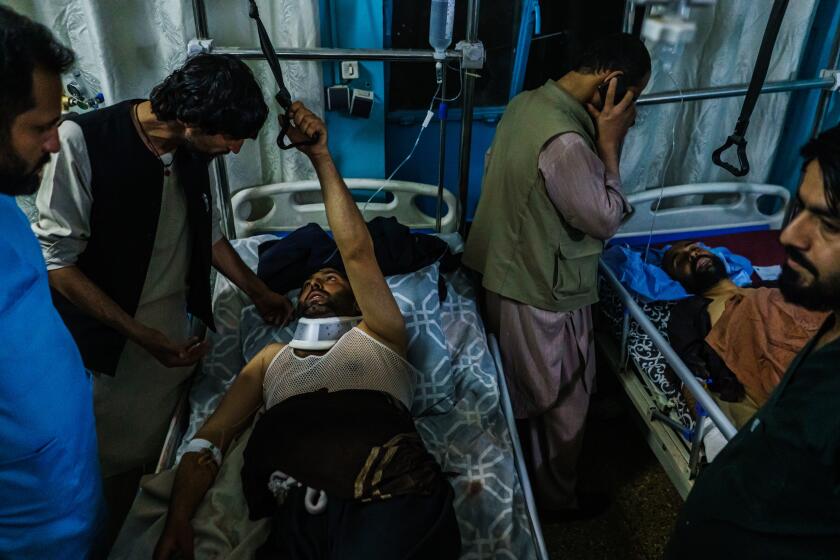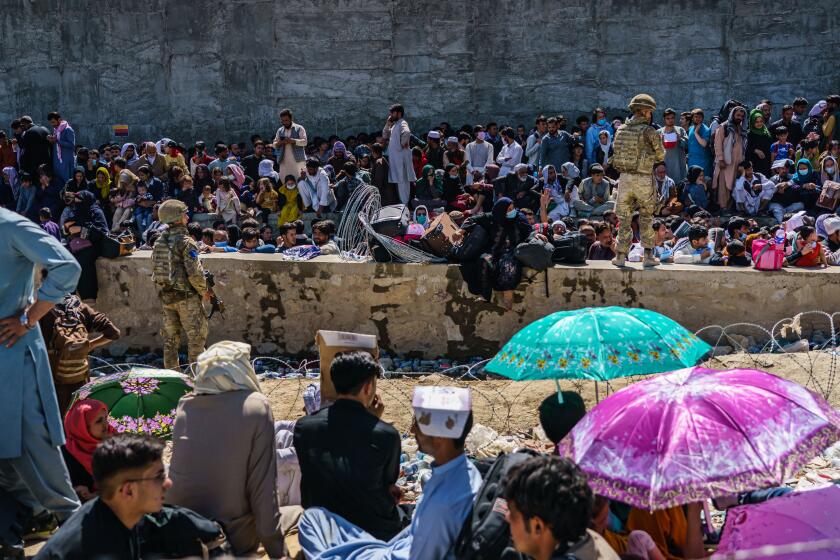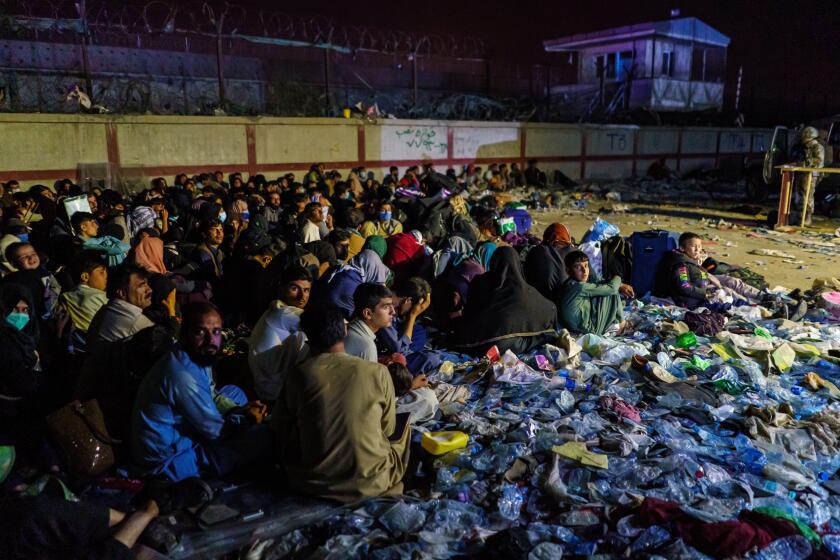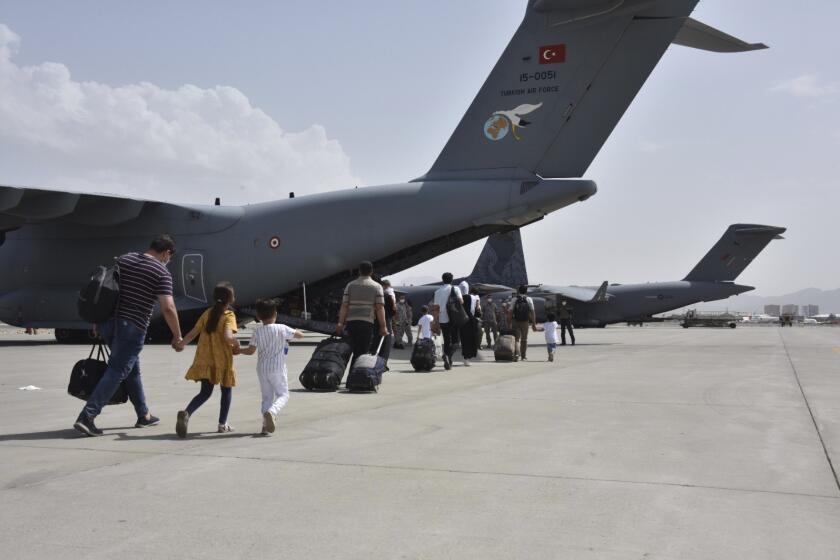U.S. presses on with evacuations despite fears of more attacks
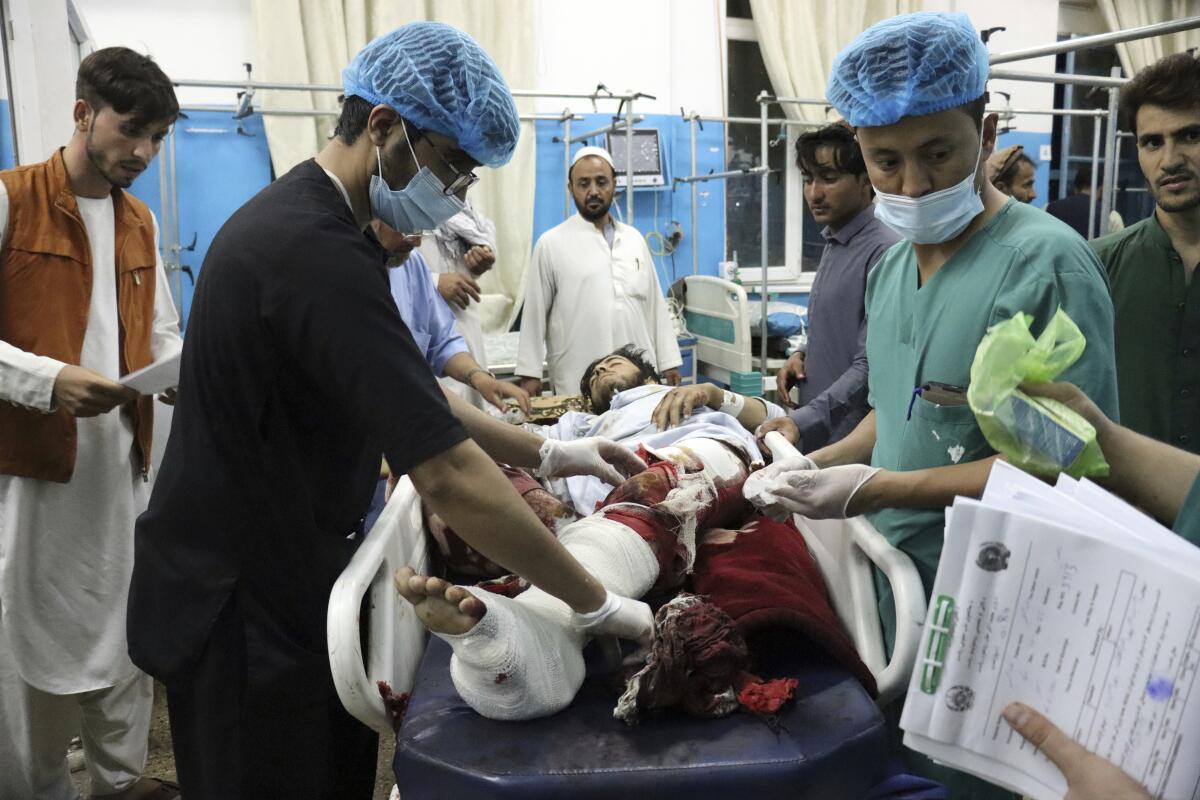
- Share via
KABUL, Afghanistan — American forces working under heightened security and threats of another attack pressed ahead with the evacuation from Kabul’s airport Friday, the day after a deadly suicide bombing wrote a devastating closing chapter on the United States’ withdrawal from its war in Afghanistan.
The death toll rose to 169 Afghans, a number that could increase as authorities examine fragmented remains, and 13 U.S. service members.
The White House and the Pentagon warned there could be more bloodshed ahead of President Biden’s fast-approaching deadline Tuesday to end the airlift and withdraw American forces. The next few days “will be our most dangerous period to date” in the evacuation, White House Press Secretary Jen Psaki said.
Thursday’s bombing — blamed on Afghanistan’s offshoot of the Islamic State group, a lethal enemy of both the Taliban and the West — marked one of the most lethal attacks the country has seen. The U.S. said it was the deadliest day for American forces in Afghanistan since 2011.
A bombing killed 13 U.S. service personnel and more than 169 Afghans on Thursday outside the airport in Kabul.
As the call to prayer echoed Friday through Kabul, the Afghan capital, along with the roar of departing planes, anxious crowds thronging the airport in hopes of escaping Taliban rule appeared as large as ever despite the scenes of victims lying closely packed together in the aftermath of the bombing.
Around the world, newly arriving Afghan evacuees, many clutching babies and bare handfuls of belongings in plastic bags, stepped off evacuation flights in the United States, in Albania, in Belgium and beyond. In Kabul on Friday, Afghan families looked for loved ones among bodies, placed along a hospital sidewalk for identification, of bombing victims who died pleading for a seat on the U.S.-run airlifts.
Afghans, American citizens and other foreigners were all acutely aware the window was closing to get out via the airlift.
Jamshad went to the airport Friday with his wife and three small children. He clutched an invitation to a Western country he didn’t want to identify.
A bombing killed 13 U.S. service personnel and more than 169 Afghans on Thursday outside the airport in Kabul.
“After the explosion, I decided I would try because I am afraid now there will be more attacks, and I think now I have to leave,” said Jamshad, who like many Afghans uses only one name.
The Pentagon said Friday that there was just one suicide bomber — at the airport gate — not two, as U.S. officials initially said. A U.S. official said the suicide bomber carried a heavier-than-usual load of about 25 pounds of explosives, loaded with shrapnel.
The U.S. official spoke on condition of anonymity to discuss preliminary assessments of the attack. The officials who gave the Afghan death toll also spoke on condition of anonymity because they were not authorized to talk to the media.
The Afghan victims included a young journalist and an impoverished father, driven to the airport by hopes of a better life.
The American dead were 11 Marines, a Navy sailor and an Army soldier. Many had been tiny children when U.S. forces first entered Afghanistan in 2001.
One, Marine Lance Cpl. Kareem Mae’lee Grant Nikoui, sent a video to a family friend in the United States just hours before he was killed, showing him smiling and greeting Afghan children.
“Want to take a video together, buddy?” Nikoui asked a young boy, leaning in to be in the picture with him. “All right, we’re heroes now, man.”
British officials said two of the country’s citizens and the child of another Briton also were among those killed when the bomb exploded.
You can help Afghan refugees by donating money to or volunteering with organizations in California.
On the morning after the attack, the Taliban posted a pickup full of fighters and three captured Humvees and set up a barrier about 1,600 feet from the airport, holding the crowds farther back from the U.S. troops at the airport gates than before.
U.S. military officials said that some gates were closed and other security measures put in place. They said there were tighter restrictions at Taliban checkpoints and fewer people around the gates. The military said it had also asked the Taliban to close certain roads because of the possibility of suicide bombers in vehicles.
The terrorist group Islamic State in Khorasan, known as ISIS-K, is thought to be responsible for Thursday’s deadly bombing near the airport. Here’s what we know about it.
The Pentagon said the U.S. would keep up manned and unmanned flights over the airport for surveillance and protection, including the use of AC-130 gunships.
U.S. officials said evacuees with proper credentials still were being allowed through the gates. Inside, about 5,400 evacuees awaited flights.
In Washington, U.S. commanders briefed Biden on developing plans to strike back at Islamic State and make good on the president’s vow to the attackers to “hunt you down and make you pay.”
The president on Friday called U.S. efforts to evacuate Americans, Afghan allies and others most at risk from the Taliban a “worthy mission.”
“And we will complete the mission,” he said.
The U.N. Security Council called the Afghanistan affiliate of Islamic State’s targeting of fleeing civilians and those trying to help them “especially abhorrent.”
The Biden administration has tapped U.S. air carriers to help in the evacuation of Afghanistan. Here’s how that works.
The Taliban has wrested back control of Afghanistan two decades after it was ousted in a U.S.-led invasion following the Sept. 11, 2001, terror attacks, which were orchestrated by Al Qaeda extremists being harbored in the country. Their return to power has terrified many Afghans, who have rushed to flee the country ahead of the American withdrawal.
More than 100,000 people have been safely evacuated through the Kabul airport, according to the U.S., but thousands more are struggling to leave in one of history’s biggest airlifts.
The White House said Friday afternoon that U.S. military aircraft had flown out 2,100 evacuees in the previous 24 hours. Another 2,100 people left on other coalition flights.
The number was a fraction of the 12,700 people carried out by U.S. military aircraft one day early in the week, when the now 2-week-old airlift not only met but exceeded intended capacity for a couple days.
France ended its own evacuation effort and pulled up stakes on a temporary French Embassy at the airport, leaving Taliban-ruled Afghanistan. U.S. allies and others have ended or are ending their airlifts, in part to give the U.S. time to wrap up its own operations.
Breaking News
Get breaking news, investigations, analysis and more signature journalism from the Los Angeles Times in your inbox.
You may occasionally receive promotional content from the Los Angeles Times.
The Taliban has said it would allow Afghans to leave via commercial flights after the U.S. withdrawal, but it remains unclear which airlines would return to an airport controlled by the militants.
Untold numbers of Afghans, especially ones who had worked with the U.S. and other Western countries, are now in hiding from the Taliban, fearing retaliation despite the group’s offer of full amnesty. The new rulers have sought to project an image of moderation in recent weeks — a sharp contrast to the harsh rule they imposed from 1996 to 2001, when they forced women to wear burqas, required them to be accompanied by a male relative when they left home, forbade girls to get an education, banned television and music, and held public executions.
Akhgar reported from Istanbul, Gannon from Islamabad and Anna from Nairobi, Kenya. Darlene Superville in Washington and Rahim Faiez in Turkey contributed along with other Associated Press writers around the world.
More to Read
Sign up for Essential California
The most important California stories and recommendations in your inbox every morning.
You may occasionally receive promotional content from the Los Angeles Times.
